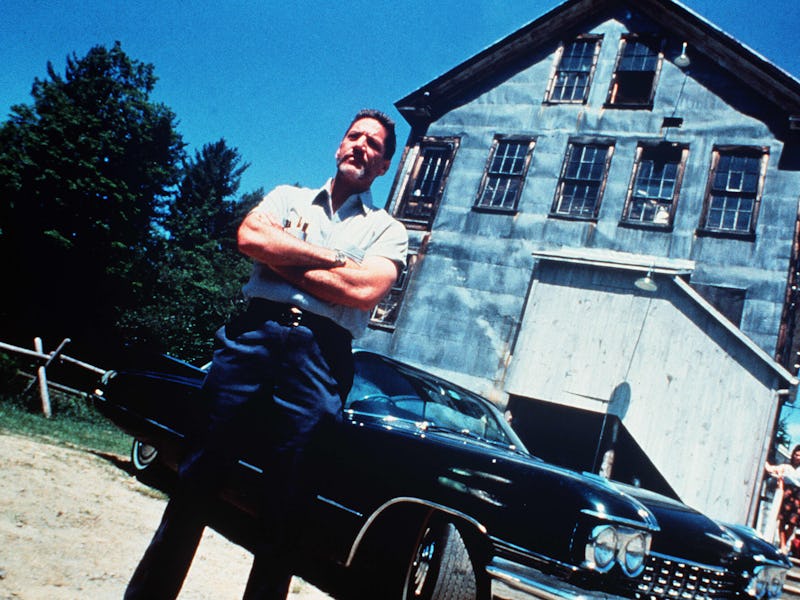The Notorious Thriller That Ended The First Era Of Stephen King Movies
Graveyard Shift would put the wave of Stephen King adaptations six feet under.

All creative endeavors seem to go in cycles, and so it seems with the many films and TV projects adapted from the works of Stephen King. The initial wave of King adaptations followed a progression that would repeat itself in the decades to come, with high-quality, high-profile projects giving way to quick, cheap cash grabs. Following two early adaptations — the 1976 film Carrie and the 1979 miniseries Salem’s Lot, both of which were highly acclaimed — the first major frenzy began in 1980 with Stanley Kubrick's expensive, prestigious The Shining, and ended 10 years later… with a low-budget B-movie about rats.
Released 35 years ago, Graveyard Shift was based on one of King’s earliest professional sales, a short story of the same name that was first published in 1970 and later in his seminal 1978 collection Night Shift. The original story revolves around a textile mill worker named Hall who is recruited, along with other employees, by their sadistic boss Warwick to undertake an extensive cleanup of the building. As they descend into the mill’s long-unexplored basement levels, they discover a massive population of mutated rats. The tale ends with Warwick and Hall both devoured by a giant queen rat in the deepest level beneath the mill, as the other workers head down to find out what happened to them.
The movie struggles to expand King’s story by introducing several additional characters, including a couple of women and an eccentric Vietnam vet exterminator named Cleveland (Brad Dourif, probably the best thing in the film). Warwick (Stephen Macht using a heavy Maine accent) is under pressure to close the mill down after years of health and safety violations, setting up a direct clash with Hall (David Andrews) and Cleveland, who insists the mill can’t be salvaged. Meanwhile, the queen rat lurks below and picks off the workers one by one in an attempt to keep gore fans watching.
Directed by Ralph S. Singleton and filmed mostly at a real mill in King’s home state of Maine, Graveyard Shift is neither good nor scary. Dourif aside, the cast is unremarkable, the visual effects okay if rubbery (the monster is more bat than rat), and despite some atmospheric location work, the movie has a stink of cheapness and cynicism. It carries a 0% rating on Rotten Tomatoes (albeit based on just seven reviews), users at IMDb mostly dislike it, and King himself even told Deadline that it was one of his least favorite adaptations — “just kind of a quick exploitation picture,” as he described it.
Not surprisingly, Graveyard Shift was a box office dud and quickly vanished from view. It also brought an ignominious close to a decade that had started with films like The Shining, King and George A. Romero’s entertaining EC Comics tribute Creepshow (1982), David Cronenberg’s excellent The Dead Zone (1983), and Rob Reiner’s Oscar-nominated Stand By Me (1986), before trailing off with mediocre entries like Cat’s Eye (1985) and King’s own directorial effort, Maximum Overdrive (1986), as well as pure slop like Children of the Corn (1984) and Creepshow 2 (1987).
Brad Dourif is the one highlight of the movie.
The simple problem was that the initial success of films like Carrie and The Shining led money-hungry producers to swoop in and adapt any King property they could get their hands on, eager to slap his name on movie screens without considering whether the material was worthy of adaptation or not. “Graveyard Shift,” the story, is a perfectly creepy, gory example of King’s early style of writing, owing a big debt to H.P. Lovecraft and those EC horror comics he paid tribute to in Creepshow. But stretching it to even just 87 minutes, without the resources to add some cinematic polish to it, resulted in the kind of dross that has given King a bad name at the box office over and over again.
And yet ironically, even as Graveyard Shift disappeared following its Halloween 1990 release, it was followed just a month later by Rob Reiner’s Misery, still one of the very best King adaptations to this day — and the first to win an Oscar, with Kathy Bates earning Best Actress for her portrayal of Annie Wilkes. But with the exception of Misery and 1999’s The Green Mile, it wouldn’t be until 2017 that King had a genuine box office hit to his name again, in the form of It: Chapter One. Even the beloved The Shawshank Redemption (1994) tanked upon its initial release, lost in a sea of turkeys like The Lawnmower Man (1992), Needful Things (1993), The Mangler (1995), and an onslaught of Children of the Corn sequels.
Did Graveyard Shift play even a minor role in burying King at the box office for the next quarter-century? Perhaps. It may or may not be the worst King-based movie ever (and no, it’s not worthy of reappraisal either, despite its new 4K Blu-ray upgrade), but it’s a definitive example of movie producers swarming — like rats — to shove anything with the author's name on it into a marketplace that rejected the King brand as often as it embraced it.